Family name: Poaceae Barnhart
Synonym(s): Aegilopaceae Martinov; Agrostidaceae Bercht. & J. Presl; Alopecuraceae Martinov; Andropogonaceae Martinov; Anomochloaceae Nakai; Anthoxanthaceae Link; Arundinaceae Döll; Arundinellaceae Herter; Asperellaceae Link; Avenaceae Martinov; Bambusaceae Bercht. & J. Presl; Cenchrinaceae Link; Chaeturaceae Link; Chloridaceae Bercht. & J. Presl; Coleanthaceae Pfeiff.; Cynodontaceae Link; Cynosuraceae Link; Echinariaceae Link; Ehrhartaceae Link; Eragrostidaceae Herter; Festucaceae Spreng.; Glyceriaceae Link; Gramineae Juss., nom. cons.; Hordeaceae Bercht. & J. Presl; Lepturaceae Herter; Miliaceae Link; Ophiuraceae Link ex Pfeiff., nom. inval.; Oryzaceae Bercht. & J. Presl; Panicaceae Bercht. & J. Presl; Pappophoraceae Herter; Parianaceae Nakai; Paspalaceae Link; Phalaridaceae Link; Pharaceae Herter; Sporobolaceae Herter, nom. inval.; Stipaceae Bercht. & J. Presl; Streptochaetaceae Nakai; Triticaceae Link; Zoysiaceae Link
Common name(s): grass family
*Number of genera/species: 780/12,000
spikeletspikelet:
basic unit of the grass inflorescence, commonly consisting of a pair of glumes and one to many florets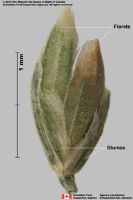 , floretfloret:
, floretfloret:
the unit of a grass spikelet consisting of a flower or caryopsis, with lemma and palea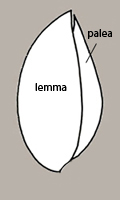 , fruit, or seed
, fruit, or seed
Fruit usually a caryopsiscaryopsis:
a small, indehiscent, dry, fruit with a thin wall surrounding and more or less fused to a single seed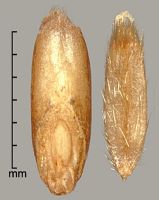 , sometimes a utricleutricle:
, sometimes a utricleutricle:
a small, indehiscent, dry fruit with a thin wall (bladderlike) that is loose and free from the seed, derived from a single, superior, simple ovary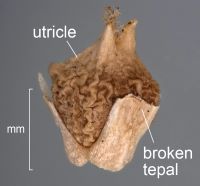 (Crypsis, Sporobolus, Eleusine), rarely an acheneachene:
(Crypsis, Sporobolus, Eleusine), rarely an acheneachene:
a dry, indehiscent, one-seeded fruit, with seed attached to pericarp at a single point, derived from a single, superior, simple or compound, one-loculed ovary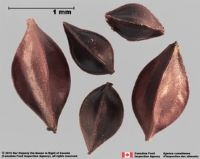 , nutnut:
, nutnut:
a fairly large, indehiscent, dry fruit with a thick and bony wall surrounding a single seed, derived from a single, simple or compound ovary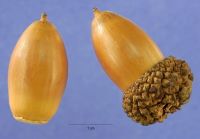 , or berryberry:
, or berryberry:
an indehiscent, fleshy fruit with one or a few to many seeds. The flesh may be homogenous throughout. Or, if the outer part is hard, firm, or leathery, referred to as an hesperidium. Septa are present in some, and the seeds may be arillate or with a fleshy testa.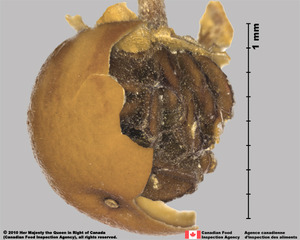 (Melocanna baccifera), 0.3–40 mm long, globoseglobose:
(Melocanna baccifera), 0.3–40 mm long, globoseglobose:
3D shape—more or less spherical to falcatefalcate:
to falcatefalcate:
shaped like a scythe or sickle , tereteterete:
, tereteterete:
approximately circular in cross section; width and thickness approximately equal
 , angledangular:
, angledangular:
2D shape—having sides that meet at acute or obtuse angles
, or compressedcompressed:
flattened; in grasses, used to denote compression (not necessarily flattened) either laterally or dorsiventrally
in transection, sometimes sulcatesulcate:
surface relief—having one or more elongate, relatively narrow and shallow depressions or grooves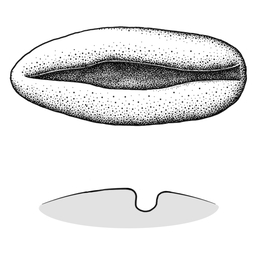 , sometimes beakedbeak:
, sometimes beakedbeak:
a usually firm, terminal appendage, sometimes tapered , usually accessory tissue including glume(s), lemmalemma:
, usually accessory tissue including glume(s), lemmalemma:
in grasses, the lower of the two bracts subtending the flower or caryopsis (compare palea)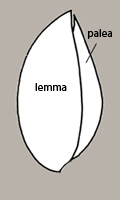 , paleapalea:
, paleapalea:
in grasses, the uppermost bract enclosing the flower or caryopsis (compare lemma)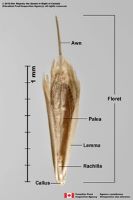 , and/or stylesstyle:
, and/or stylesstyle:
in a flower, the narrow and elongated part of the pistil between the stigma and the ovary; sometimes persisting in fruit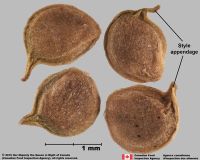 persistent, with one seed. Pericarppericarp:
persistent, with one seed. Pericarppericarp:
fruit wall or fruit coat
usually fused to seed coat, black, brown, purple, yellow, red, or white, shinyshiny:
uniformly reflecting a high proportion of incident light at all angles or dulldull:
or dulldull:
reflecting only a low proportion of incident light, with no apparent sheen , membranousmembranous:
, membranousmembranous:
texture—extremely thin, pliable, and fairly tough
, fleshy, leatheryleathery:
texture—moderately thick, tough, and very pliable
, or crustaceouscrustaceous:
texture—thin, dry, indurate, and brittle
, smooth, groovedgrooved:
surface relief—linear depressions that may be single or form a series of grooves over the surface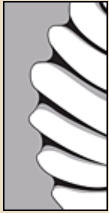 , ribbedribbed:
, ribbedribbed:
surface relief—wide, prominent, linear ridges that are generally rounded and longitudinally situated on the surface , striatestriate:
, striatestriate:
surface relief—having fine, parallel lines, grooves or ridges , wrinkledwrinkled:
, wrinkledwrinkled:
surface relief—shallow, irregular folds and furrows covering the surface; appearing overall though crumpled and then spread out , or spinyspiny:
, or spinyspiny:
having slender, stiff, sharp projections oriented in the general plane of the structure , sometimes pubescentpubescent:
, sometimes pubescentpubescent:
surface relief—bearing hairs
.
Seeds oblongoblong:
2D shape—much longer than broad with nearly parallel sides, corners are rounded , tereteterete:
, tereteterete:
approximately circular in cross section; width and thickness approximately equal
 , turtle-shaped, angularangular:
, turtle-shaped, angularangular:
2D shape—having sides that meet at acute or obtuse angles
, or compressedcompressed:
flattened; in grasses, used to denote compression (not necessarily flattened) either laterally or dorsiventrally
in transection, 0.3–40 mm long. Hilumhilum:
on seeds, the scar indicating where the funiculus was attached; on grass caryopses, the scar visible on the outer fruit surface revealing where the seed is attached on the inner fruit wall surface; or in Asteraceae cypselae, the scar visible on the outer fruit wall revealing where the fruit was attached to the receptacle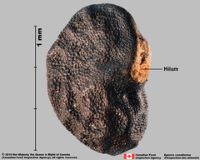 present, punctatepunctate:
present, punctatepunctate:
surface relief—dotted with pits or with translucent, sunken glands or with colored dots, similar to pitted or larger than punctatepunctate:
or larger than punctatepunctate:
surface relief—dotted with pits or with translucent, sunken glands or with colored dots, similar to pitted , often linearlinear:
, often linearlinear:
(shape) long, narrow, and uniform in width; (of embryo) embryo is straight and much longer than wide . Seed coat brown, thin, unsmooth.
. Seed coat brown, thin, unsmooth.
Embryo well developed, linearlinear:
(shape) long, narrow, and uniform in width; (of embryo) embryo is straight and much longer than wide , straight or curvedcurved:
, straight or curvedcurved:
(of embryo) linear embryo is curved into an arch or horseshoe with the ends far apart , completely or partially filling seed coat, obliqueoblique:
, completely or partially filling seed coat, obliqueoblique:
in a slanting direction or position, neither horizontal nor vertical
to the seed length, positioned abaxially, scutellumscutellum:
the single, relatively large cotyledon of a grass embryo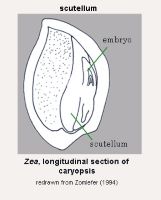 present and appressedappressed:
present and appressedappressed:
pressed close to or lying flat against something, as in hairs on grass bract
to endosperm.
Endosperm usually copious (lacking in Melocanna), transparent, fleshy, mealymealy:
loose, dry, and disintegrating in finely granular
pieces like meal or flour
, hard, or watery in a few genera.
Noxious Weeds: USA Federal Noxious Weed List, all are terrestrial, Avena sterilis Linnaeus (including Avena ludoviciana Durieu); Cenchrus caudatus (Schrad.) Kuntze (=*Pennisetum macrourum Trinius); Cenchrus clandestinus (Hochst. ex Chiov.) Morrone (=*Pennisetum clandestinum Hochstetter ex Chiovenda); Cenchrus pedicellatus (Trin.) Morrone (=*Pennisetum pedicellatum Trinius); Cenchrus polystachios (L.) Morrone (=*Pennisetum polystachion (Linnaeus) Schultes); Chrysopogon aciculatus (Retzius) Trinius; Digitaria abyssinica (Hochstetter ex A. Richard) Stapf; Digitaria velutina (Forsskal) Palisot de Beauvois; Dinebra chinensis (L.) P. M. Peterson & N. Snow (=*Leptochloa chinensis (L.) Nees); Imperata brasiliensis Trinius; Imperata cylindrica (Linnaeus) Palisot de Beauvois; Ischaemum rugosum Salisbury; Nassella trichotoma (Nees) Hackel ex Arechavaleta; Oryza longistaminata A. Chevalier & Roehrich; Oryza punctata Kotschy ex Steudel; Oryza rufipogon Griffith; Paspalum scrobiculatum Linnaeus; Rottboellia cochinchinensis (Lour.) W. Clayton; Saccharum spontaneum L.; Setaria pumila subsp. pallidefusca (Schumach.) B.K. Simon; Tridax procumbens L.; Urochloa panicoides Beauvois.
*Name listed in USA Federal Noxious Weed Regulations and tool linked below.
Federal Noxious Weed Disseminules of the US tool provides descriptions and images of these species. Aquarium & Pond Plants of the World tool includes descriptions and images of genera in this family.
| Fruit | |
| Type | caryopsiscaryopsis: a small, indehiscent, dry, fruit with a thin wall surrounding and more or less fused to a single seed  , sometimes an utricleutricle: , sometimes an utricleutricle:a small, indehiscent, dry fruit with a thin wall (bladderlike) that is loose and free from the seed, derived from a single, superior, simple ovary  , rarely an acheneachene: , rarely an acheneachene:a dry, indehiscent, one-seeded fruit, with seed attached to pericarp at a single point, derived from a single, superior, simple or compound, one-loculed ovary  , nutnut: , nutnut:a fairly large, indehiscent, dry fruit with a thick and bony wall surrounding a single seed, derived from a single, simple or compound ovary  , or berryberry: , or berryberry:an indehiscent, fleshy fruit with one or a few to many seeds. The flesh may be homogenous throughout. Or, if the outer part is hard, firm, or leathery, referred to as an hesperidium. Septa are present in some, and the seeds may be arillate or with a fleshy testa.  |
| Size range | 0.3–40 mm long |
| Shape(s) | oblongoblong: 2D shape—much longer than broad with nearly parallel sides, corners are rounded  , linearlinear: , linearlinear:(shape) long, narrow, and uniform in width; (of embryo) embryo is straight and much longer than wide  , ellipsoidellipsoid: , ellipsoidellipsoid:3D shape—elliptic , ovoidovoid: 3D shape—ovate  , cylindricalcylindrical: , cylindricalcylindrical:3D shape—a cylinder, with parallel sides and a circular cross-section; tubular or rod-shaped , teardrop-shapedteardrop-shaped: 2D shape—widest point is toward one end of the fruit, the other end tapers sharply to a pointed end 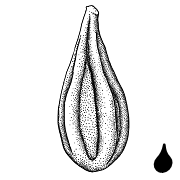 , fusiformfusiform: , fusiformfusiform:spindle-shaped; broadest at the middle and tapering at both ends 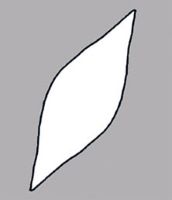 , globoseglobose: , globoseglobose:3D shape—more or less spherical  , lens-shapedlens-shaped: , lens-shapedlens-shaped:2D shape—round and flattened with two curved (convex) surfaces , falcatefalcate: shaped like a scythe or sickle  , reniformreniform: , reniformreniform:2D or 3D shape—kidney-shaped  , trigonoustrigonous: , trigonoustrigonous:3D shape—having three faces that meet at distinct angles; triangular in outline |
| Texture | membranousmembranous: texture—extremely thin, pliable, and fairly tough , fleshy, leatheryleathery: texture—moderately thick, tough, and very pliable , crustaceouscrustaceous: texture—thin, dry, indurate, and brittle |
| Surface relief | smooth, ribbedribbed: surface relief—wide, prominent, linear ridges that are generally rounded and longitudinally situated on the surface  , striatestriate: , striatestriate:surface relief—having fine, parallel lines, grooves or ridges  , groovedgrooved: , groovedgrooved:surface relief—linear depressions that may be single or form a series of grooves over the surface  , wrinkledwrinkled: , wrinkledwrinkled:surface relief—shallow, irregular folds and furrows covering the surface; appearing overall though crumpled and then spread out  , spinyspiny: , spinyspiny:having slender, stiff, sharp projections oriented in the general plane of the structure  |
| Color(s) | red, brown, white, black, yellow, purple |
| Unique features | Usually one-seeded caryopsescaryopsis: a small, indehiscent, dry, fruit with a thin wall surrounding and more or less fused to a single seed  (pericarppericarp: (pericarppericarp:fruit wall or fruit coat fused to seed coat) with persistent perianthperianth: collective term for calyx and corolla of a flower 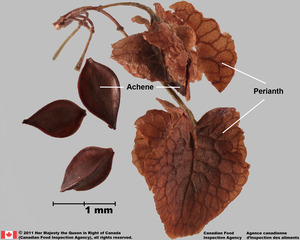 or bracts and often dispersed in a spikeletspikelet: or bracts and often dispersed in a spikeletspikelet:basic unit of the grass inflorescence, commonly consisting of a pair of glumes and one to many florets  . . |
| Seed | |
| Size range | 0.3–40 mm long |
| Shape(s) | oblongoblong: 2D shape—much longer than broad with nearly parallel sides, corners are rounded  |
| Surface relief | unsmooth |
| Color(s) | brown |
| Unique features | Seeds tightly fused to pericarppericarp: fruit wall or fruit coat with scutellumscutellum: the single, relatively large cotyledon of a grass embryo  present. present. |
| Other | |
| Embryo | well developed, linearlinear: (shape) long, narrow, and uniform in width; (of embryo) embryo is straight and much longer than wide  , straight or curvedcurved: , straight or curvedcurved:(of embryo) linear embryo is curved into an arch or horseshoe with the ends far apart  , completely or partially filling seed coat, obliqueoblique: , completely or partially filling seed coat, obliqueoblique:in a slanting direction or position, neither horizontal nor vertical to the seed length, positioned abaxially, scutellumscutellum: the single, relatively large cotyledon of a grass embryo  present present |
| Nutritive tissue | usually copious (lacking in Melocanna), transparent, fleshy, mealymealy: loose, dry, and disintegrating in finely granular pieces like meal or flour , hard, or watery in a few genera |
Worldwide.
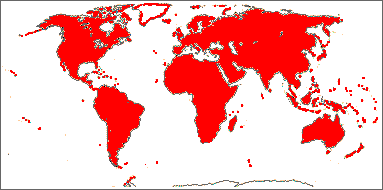
Distribution map courtesy of Angiosperm Phylogeny Website.
Key to the grass genera of the world
Grass Spikelet Structures Of Diagnostic Value
Baskin and Baskin 2021Baskin and Baskin 2021:
Baskin C and Baskin J. 2021. Relationship of the lateral embryo (in grasses) to other monocot embryos: A status up-grade. Seed Science Research 31 (3): 199-210. doi:10.1017/S0960258521000209; Dahlgren et al. 1985Dahlgren et al. 1985:
Dahlgren RMT, Clifford HT, and Yeo PF. 1985. The families of the monocotyledons: structure, evolution, and taxonomy. Springer-Verlag, Berlin. 520 pp.; Flora of North America Editorial Committee 1993+Flora of North America Editorial Committee 1993+:
Flora of North America Editorial Committee, eds. 1993+. Flora of North America North of Mexico [Online]. 22+ vols. Flora of North America Association, New York and Oxford. Accessed January-March 2024. URL: http://beta.floranorthamerica.org.; Kirkbride et al. 2006Kirkbride et al. 2006:
Kirkbride JH, Jr, Gunn CR, and Dallwitz MJ. 2006. Family guide for fruits and seeds, vers. 1.0. Accessed September 2020-January 2022. URL: https://nt.ars-grin.gov/seedsfruits/keys/frsdfam/index.cfm .; Kubitzki et al. 1990+Kubitzki et al. 1990+:
Kubitzki K et al., eds. 1990+. The families and genera of vascular plants. 7+ vols. Berlin etc.; Stevenson and Loconte 1995Stevenson and Loconte 1995:
Stevenson DW and Loconte H. 1995. A cladistic analysis of monocot families. In: Rudall PJ, Cribb PJ, Cutler DF, and Humphries CJ, eds. Monocotyledons: Systematics and Evolution. Royal Botanic Gardens, Kew.; Watson and Dallwitz 1992+Watson and Dallwitz 1992+:
Watson L and Dallwitz MJ. 1992+. The families of flowering plants: descriptions, illustrations, identification, and information retrieval. Version: 6th Accessed September 2020-September 2022. URL: delta-intkey.com; Zhengyi et al. 2004+Zhengyi et al. 2004+:
Zhengyi W, Raven PH, and Deyuan H. 2004+. Flora of China [online]. 25 vols. Science Press, Beijing China & Missouri Botanical Garden, St. Louis USA. Accessed January–March 2024. http://flora.huh.harvard.edu/china/
*The number of genera and species is based on Christenhusz and Byng 2016Christenhusz and Byng 2016:
Christenhusz MJM and Byng JW. 2016. The number of known plant species in the world and its annual increase. Phytotaxa 261 (3): 201-217. https://doi.org/10.11646/phytotaxa.261.3.1, which may differ from the number of genera in GRIN-Global.